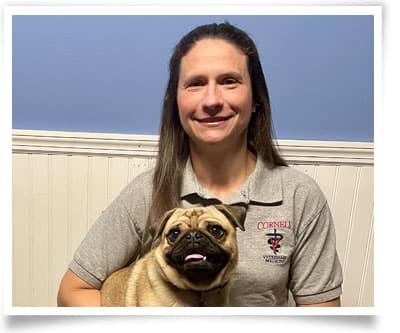Everything You Need to Know About Dog Grooming: Insights from Veterinarians
As someone who has turned to the internet for answers on dog grooming, you've shown yourself to be a conscientious pet owner who wants their pooch to be clean and comfortable. At GeniusVets, we firmly believe that petcare information should come from veterinarians and not from “Dr. Google", as anyone with a computer can share information these days—whether it's factual or not. That’s why we’ve taken FAQs on dog grooming, sent these questions to renowned veterinarians across the U.S., and compiled their replies to get you valuable information that you can trust.
While we've sourced all of the dog grooming information and recommendations below directly from leading veterinarians across the country, please make sure to seek out the advice of your own veterinarian or find a trusted vet near you using the GeniusVets Directory.
Do all dogs require grooming?
All dogs require some sort of help with hygiene over their lifetime, but not all dogs require professional grooming. There are certainly some breeds that need to have regular grooming in terms of haircuts and maintaining coats. To give you an example, breeds like poodles or poodle mixes (doodles) will have continuously growing hair versus fur, think hair grows, fur will shed. Dogs with hair will benefit from regular professional grooming - that is unless you want to learn those skills yourself. But for your average dog that is not one of those particular breeds, hygiene is still essential. We want to make sure that they maintain good dental hygiene, good body hygiene, and healthy nails. Regular nail trimming or nail maintenance, keeping their coat brushed and clean, and regular teeth brushing are essential tasks. And if you have a dog with skin conditions, they may benefit from more frequent bathing, but you should consult with your veterinarian about that. Also, you shouldn't shave a dog that has a double coat. Consult your veterinarian before you do so, as they will discuss the importance of your pet's fur in regards to regulating body temperature, and what to do if your dog does need to be shaved.
How important are grooming and hygiene for my dog's health?
Good hygiene and grooming practices are essential for happy, healthy dogs in the long term. Not only does grooming make dogs look and feel better, but it may uncover some medical conditions in between wellness exams, and it can help prevent medical conditions from occurring.
What do I need to do when grooming my dog?
Ideally, if we're starting as a puppy, we want to condition them to positively associate grooming with things they love, such as treats. Try to make nail trims and getting brushed fun, and associate those tasks with food or some sort of fun activity or playtime afterward. And if you have a dog that has had some negative grooming experiences previously, work with them to counter-condition.
Make sure your dog is comfortable in the space that you’re grooming. If you’re having the dog take a bath, ensure you have good traction and water temperature. If you and your dog are not comfortable with trimming nails, you can work on counter-conditioning or even scratchboard training as good alternatives. You’ll want to condition to toothbrushing as well, as going at most dogs with a toothbrush is going to make them confused and a bit worried about what you're doing. Thankfully, your veterinarian will certainly have great resources for helping your dog learn to have their teeth brushed comfortably.
You can cover the basics of grooming at home, brushing your dog's coat, cleaning their ears, and trimming nails, but you should always have a professional groomer handle any clipping of the hair or shaving, as the tools that are used for those can be dangerous if you are not experienced.
Recommended Products for Dog Grooming
Grooming is more than just keeping your dog looking good—it's an important part of maintaining skin, coat, and overall health. Regular grooming sessions help reduce shedding, prevent mats and skin issues, and create bonding time with your pup. These veterinarian-recommended products help pet parents handle bathing, brushing, ear care, nail trimming, and more from home with ease.
Shampoos, Conditioners & Leave-On Products
- Hypoallergenic Dog Shampoo – A mild shampoo for dogs with sensitive skin.
- Veterinary Formula Hypoallergenic Dog Shampoo – Fragrance- and soap-free for allergy-prone dogs.
- Hot Spot & Itch Relief Shampoo – Soothes and calms irritated skin.
- Antiseptic & Antifungal Shampoo – Ideal for pets with fungal or bacterial skin infections.
- Clinical Care Hypoallergenic Shampoo – Gentle cleansing for allergy-prone pets.
- DOUXO Leave-On Mousse – A no-rinse mousse for refreshing the coat and soothing skin.
- DOUXO Dog Shampoo – Deep cleans and nourishes without irritation.
- DOUXO Oatmeal Conditioner – Detangles and adds shine while moisturizing.
- Virbac Allergroom Shampoo – Soap-free formula for dry, itchy skin.
- PetAg Fresh ’n Clean Shampoo – 18 oz – Floral-scented and enriched with Aloe Vera and Vitamin E.
- PetAg Fresh ’n Clean Shampoo – 1 Gallon – Perfect for multi-pet households.
- PetAg Fresh ’n Clean Cologne Spray – Floral-scented spray that helps control odor between baths.
- ZYMOX Enzymatic Leave-On Conditioner – Moisturizing formula that soothes and detangles.
Top Picks
Looking for a shampoo that’s safe and effective for regular use? The DOUXO Dog Shampoo is a vet-trusted favorite for gentle cleansing and coat health.
How often should my dog be groomed?
Grooming frequency varies depending on the individual dog. Most of your longer-haired dogs are going to need grooming pretty regularly. That could be as frequent as every month for certain breeds and then other breeds need it less frequently. You should discuss this with a professional groomer to establish what makes the most sense for your dog and what's going to benefit them. And it's not just about them looking nice, of course, although that's part of it. Grooming is also about their comfort, so that should be something that you discuss with your groomer.
How soon should I start to groom my dog?
Immediately, within reason. If you have a dog coming into your household with some fear or anxiety, you don't want to go running at that dog with a pair of nail clippers or a brush. Your puppy should have their first set of vaccinations and should be used to your home before taking them to the groomer for services. You can always take your puppy in and have the groomer give a treat so they can associate the groomer with a positive experience before they can come in to get a groom or a nail trim. In general, though, we recommend that a pup gets to the groomer at about 12 to 16 weeks of age, so you want to start preparing them. Engage in concise sessions where you're building a positive association with the nail clippers, the dog brush, or looking in their ears, as this can help develop a lifetime of good hygiene practices. Get the pup used to having their ears and feet touched so nothing goes wrong at their first grooming session.
What should I do for my puppy’s first grooming?
Check with your groomer on what they recommend because they will often have a manner in which they like to do things. They might want you to come in for a short visit beforehand to do a little meet and greet, or they might let you set up the expectations before your visit.
If you're doing grooming at home, start by building some positive associations before you even get to the bathing aspect or the grooming aspect. As we’ve mentioned, build some familiarity with the toothbrush or the nail trimmers. Pairing food with these activities can be beneficial. But if you have questions or concerns about how to prepare or how to ease into things, give your vet a call. They can surely provide you with several great resources on training and conditioning.
Do I need any special tools for dog grooming?
There is a bit of an art to pet grooming. First and foremost, you're going to need nail trimmers. Most veterinary clinics and, of course, groomers use industrial-strength clippers. We want the nail trimmers to cut but not crush the nails, as we don’t want trimming to be painful for your dog. The second thing you might want to have on hand is some ear cleaner and a bit of gauze. Try putting a bit of the cleaner on the ear and clean out both ears as needed. And then third, you're going to want to have a great shampoo. Oatmeal shampoos help with itching and minor problems like that. Most veterinarians will also recommend a soap-free shampoo, as it's not going to be drying to the animal. You’ll also need some kind of hairbrush, as long-haired dogs, in particular, are going to need a lot of brushing to keep their coat from getting matted. Brushing is good to remove fur, tangles and that will help the natural oils on the skin to better protect the skin and coat. Some dogs shouldn't be shaved as their coats are there to insulate them, keeping them warm and, yes, even cool. A dog should be brushed once a week, at least and more often if they have long hair, are excessively shedding, or get wet to decrease the chances of a skin infection. Regular brushing can also help with shedding. Lastly, you'll need dog toothpaste and a toothbrush, and you may need to do a bit of experimenting with the flavored toothpaste to see which your dog prefers.
For quick reference, here is the list of items you'll need for dog grooming:
- Nail clippers
- Ear cleaner and gauze
- Shampoo (vets often recommend oatmeal, soap-free)
- A dog hairbrush
- Dog toothpaste and toothbrush
Grooming Tools
- Grooming Kit with Clippers & Vacuum – Great for trimming and cleaning with reduced mess.
- Dog Shaver Clippers – Designed for comfort and safety during grooming.
- Deshedding Gloves for Bigger Dogs – Ideal for removing excess fur while washing.
- Washing Gloves for Smaller Dogs – Better control for grooming small breeds.
- Dog Nail Trimmer – Basic tool for safe nail maintenance.
- Dog Nail Grinder – Gently smooths nails after trimming.
Dental & Skin Health
- Yummy Combs Dog Dental Chews – Innovative design for deep cleaning teeth and fresh breath.
- Blue Buffalo Dental Chews – Daily dental treats that support oral hygiene.
- Nutramax Welactin Daily Omega-3 Soft Chews – Promotes a healthy coat and skin barrier.
- Nutramax Welactin Omega-3 Liquid – Reduces dryness, flakiness, and skin inflammation.
Top Picks
Want an all-in-one solution? The Grooming Kit with Clippers & Vacuum is perfect for pet parents who want to keep their dog neat without a mess.
For fresh breath and clean teeth, Yummy Combs Dental Chews offer more than just a treat—they actively clean and protect your dog’s smile.
How does regular grooming contribute to my dog's health?
Keeping your dog clean and in good condition is going to maintain optimal health just as proper nutrition does. When you don't groom dogs, their coats can get very dirty, their skin can get clogged, and their coats can get matted. If you keep them properly trimmed to the right length and for those that shed, keep all the undercoat out, the skin has a chance to breathe and become healthy, and you're less likely to develop any bacterial infections.
Regular grooming will also allow you to get an in-depth look at your dog, so you may notice a little bump, scrape, or scratch that you hadn't before. It's going to help loosen any dead fur that needs to be groomed out, especially our Labradors, Shepherds, or Huskies that blow their coat once or twice a year. It’s also a good time to check for fleas and ticks.
You also want to make sure that you’re checking your dog’s ears to ensure there’s not a significant wax buildup, signs of infection, a smell, or redness. Checking their teeth regularly as you’re grooming will help ensure there are no growths in the mouth and that teeth don’t look painful or discolored.
As you’re trimming nails, make sure the nails look healthy. When dogs’ nails are wet much of the time, we will see more cracked or broken nails, which we notice when we’re trimming their nails or keeping them clean. In sum, keeping your dog clean is a way to regularly examine your dog more closely than you might if you're just snuggling or petting them.
If you have any further questions about dog grooming, ask your veterinarian. If you don’t have one yet, we can help you find a local veterinarian! You can also see AAHA's business safety recommendations when it comes to dog grooming businesses, etc.
The Following Veterinarians
Contributed To The Dog Grooming Information On This Page


The Ultimate Guide
to Dog Care
This free guide is an indispensable manual for dog ownership. Filled with veterinary advice and recommendations on every important topic at each stage of your dog’s life, this is all the stuff that responsible dog owners need to know. That is why we are making it free!




